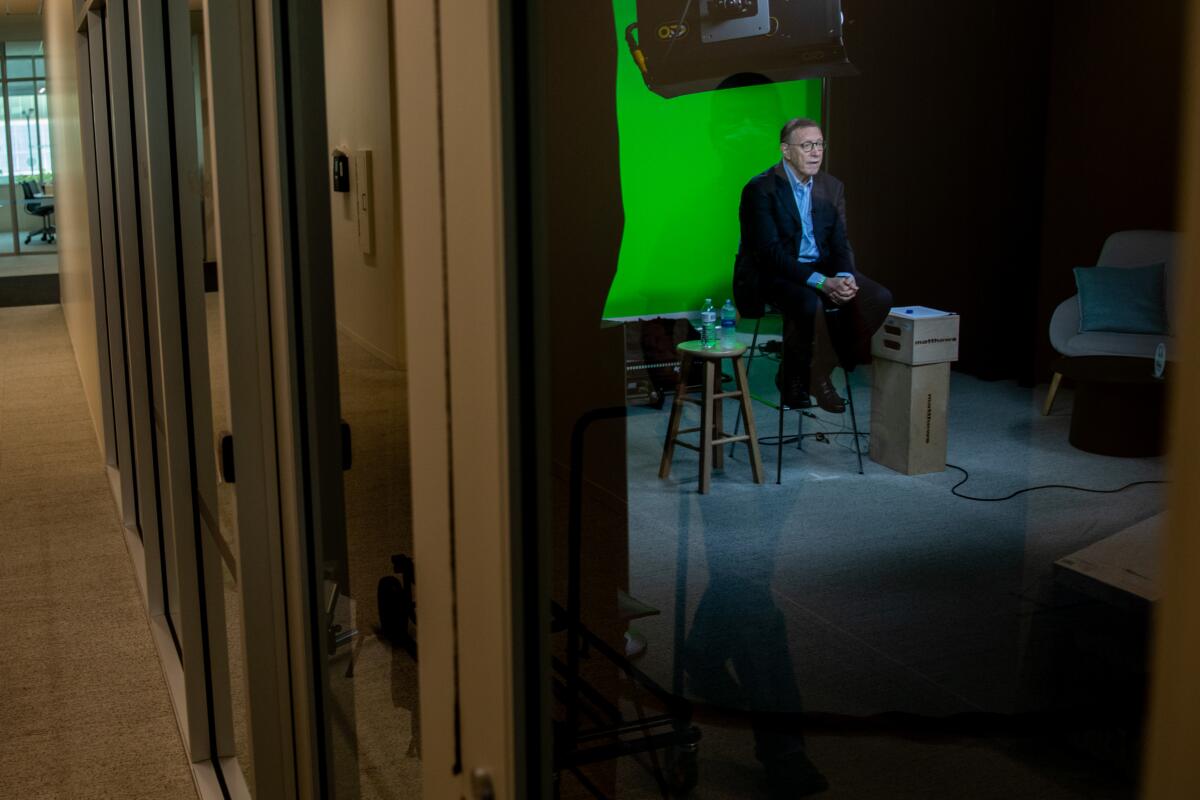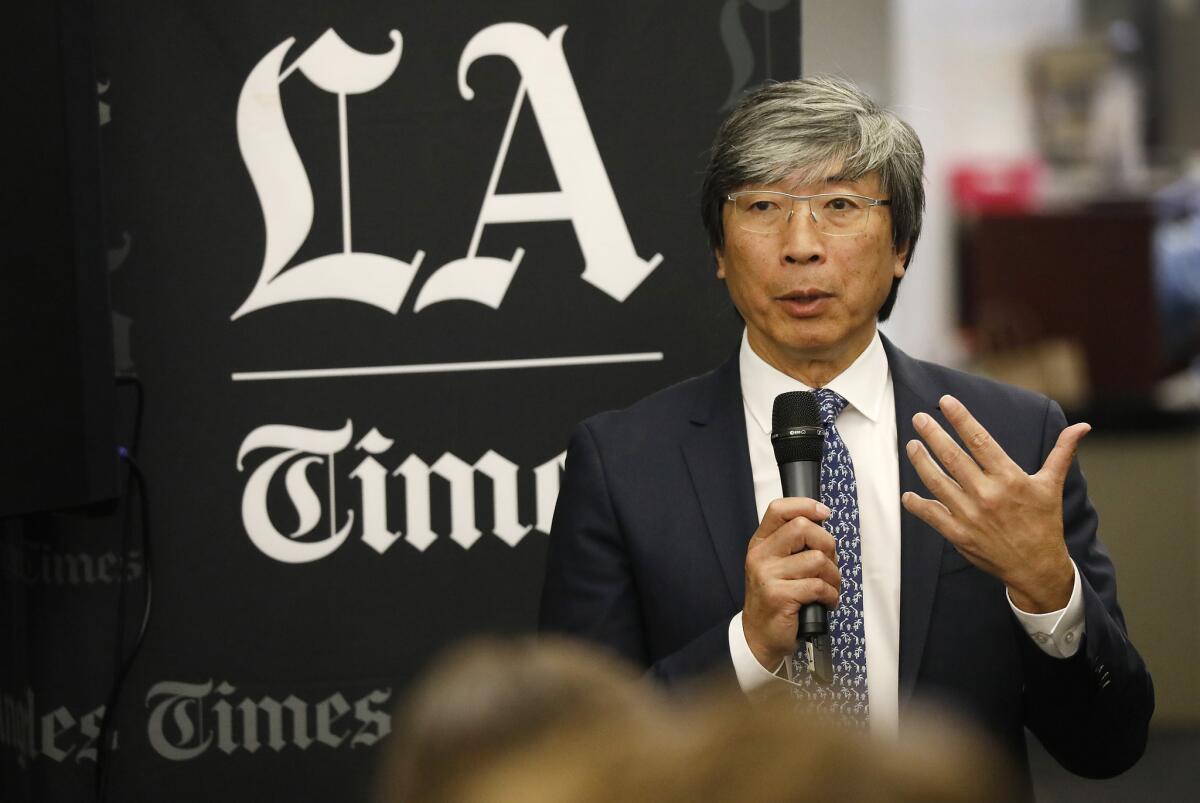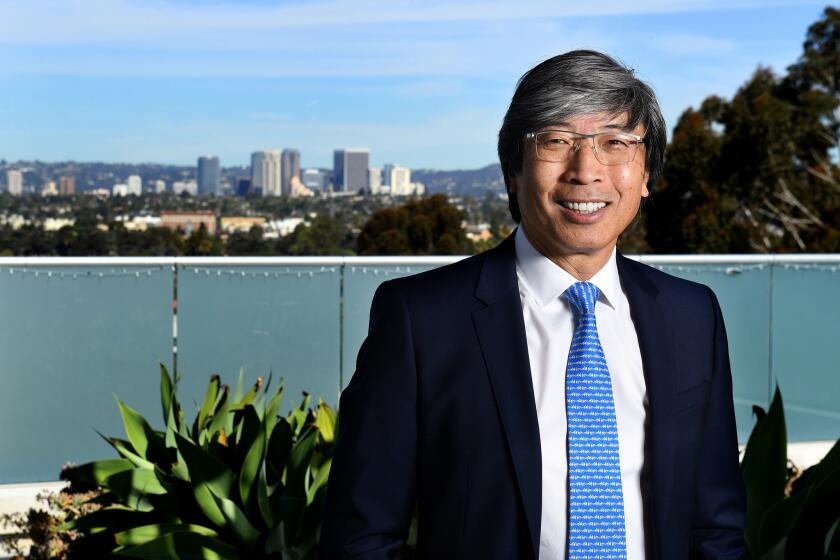L.A. Times faces painful reckoning over race in its staff and pages

Two years after the Los Angeles Times reverted to local ownership, one of the country’s largest metropolitan daily newspapers is facing a painful internal reckoning over glaring deficiencies and missteps regarding race and representation in its pages and its staff.
On Wednesday, Executive Editor Norman Pearlstine heard from aggrieved newsroom staff members during a more than four-hour meeting examining the mistreatment of Black and brown editorial staff members past and present. He acknowledged that the 138-year-old paper had failed to capitalize on an unprecedented opportunity to better diversify its newsroom since its 2018 purchase by L.A. biotech billionaire Dr. Patrick Soon-Shiong and his wife, Michele B. Chan.
For the record:
7:33 p.m. July 7, 2020An earlier version of this story and in the June 25 Section A print edition said that the Editorial Board supported Proposition 187. The Editorial Board opposed Proposition 187 but endorsed the reelection of Gov. Pete Wilson, who was a strong supporter of the measure. The article also said there were three Asian Americans in the paper’s 14-member leadership group. In fact, there are four.
Wednesday’s meeting was conducted by Zoom videoconference because staffers have been working from home during the COVID-19 pandemic. It came three weeks into a raw and deeply emotional self-examination that has unfolded on internal communications channels, a wide-ranging discussion about the paper’s news coverage and treatment of people of color. Emboldened by The Times’ first newsroom union contract, staff members have openly chastised senior editors for allowing racial disparities to persist.
Rank-and-file employees demanded that management do better.
“We all saw the river of white people coming into your office,” staff writer Esmeralda Bermudez said in a voice sometimes breaking with emotion, while directing one of the strongest critiques at Pearlstine and his hiring practices. Bermudez and others said that The Times missed chances to hire or retain staff members of color even as it embarked on a hiring spree in the initial period after Soon-Shiong’s purchase.
“We have work to do to convince you that this is just the beginning,” Pearlstine said. “It’s a great opportunity to fix things that have been wrong for a long time.”
After the May 25 killing of George Floyd, a Black man, by a white police officer in Minneapolis, journalists around the country have engaged in similar emotionally wrenching discussions about ingrained practices that have marginalized people of color.
At the New York Times, more than 800 staff members signed a petition protesting the publication of an opinion piece by Sen. Tom Cotton (R-Ark.) calling for the military to be sent into U.S. cities at the height of the protests sparked by Floyd’s killing. At the Philadelphia Inquirer, the top editor resigned after a column ran with the headline: “Buildings Matter, Too.”
“Our entire industry is going through this reckoning: How do we root out the anti-Black racism from our organization and from our coverage?” L.A. Times Deputy Managing Editor Shani Hilton said in an interview. “How do we stop the tides of white supremacy that invade, not only what we do, but all of society?”
At The Times, years of ownership turmoil, a revolving door of managers, hundreds of staff cuts and a protracted bankruptcy process a decade ago reinforced an internal hierarchy that put people of color at a disadvantage. It created a tiered newsroom, where veteran editors and reporters, who are largely white, have relied on a secondary class of primarily younger, less-experienced Latino, Asian and Black reporters who are paid significantly less than older counterparts, internal critics said.
During its bleakest days, from 2014 to 2018, the paper relied heavily on a long line of young journalists of color to fill its thinning ranks and respond to major breaking news events such as wildfires and mass shootings.
In 2018, The Times was rescued by Soon-Shiong and Chan. They paid $500 million to buy The Times and the San Diego Union-Tribune from Chicago-based Tribune Publishing, which was poised to close The Times’ Washington bureau and impose additional debilitating cuts. The Times went on an unprecedented hiring spree, bringing on 110 additional journalists.
Today, The Times newsroom employs 502 journalists, but it is 61% white, even though Los Angeles County’s population is 26% white, according to 2018 census information. Latinos represent 13% of the newsroom in a county where Latinos make up nearly half of the population. The paper’s composition of Asian American journalists mirrors the county’s population at nearly 15%. The paper has just 26 Black journalists — 5.2% of its staff — while nearly 8% of county residents are Black.

And there is only one Black reporter — Angel Jennings — in local news, Metro, the newsroom’s largest section. For 18 months, Jennings pleaded in vain with editors for a raise. City Editor Hector Becerra went to bat for her, saying that boosting her compensation was the “the right thing ...[and] also the smart thing.” But Pearlstine and other high-level editors declined, saying the paper was in the midst of negotiating its first collective bargaining agreement.
That contract was intended to resolve pay inequities for dozens of staff members. Management said it didn’t want to do individual salary negotiations during contract talks (although reporters who were being recruited by other organizations did get pay boosts).
It took 14 months to negotiate the contract, meaning that Jennings and other staff members had to wait more than a year to see their salaries grow — sometimes by as much as 60%.
“The last few years have been so painful,” Jennings, who covers Inglewood and South L.A., said in an interview. “Some days, I would cry and ask the editors: ‘Why am I being treated this way?’ It felt like what was happening to me was personal, but it was just institutional.”
During this time, Jennings’ coverage of the shooting death of rapper Nipsey Hussle attracted huge audiences that don’t normally read the L.A. Times. Her story was the third-most-read on The Times’ website in 2019. Among the stories that had the best engagement — the time that readers spent reading a story — her article was No. 1. (Jennings was given a bonus for her coverage, managers said.)
Jennings is one of six journalists who sued The Times and Tribune Publishing this month, alleging “significant pay gaps among the L.A. Times workforce.” The proposed class-action lawsuit filed in San Bernardino County Superior Court alleges that the paper violated California’s Equal Pay Act by paying women and people of color significantly less than their white male counterparts since at least 2017. The Times declined to comment on the case but said the parties had reached a settlement.
::
Soon-Shiong, a South African of Chinese descent, has personally felt the sting of racism. When he was a young doctor in South Africa under apartheid, he fought to be able to treat patients in a whites-only hospital, even if it meant accepting half the salary of the white interns.
“You cannot understand racial inequality until you’ve truly lived it,” Soon-Shiong said in an interview. “We cannot and will not tolerate racism. More importantly, this paper has an opportunity to not only address it, but address it in ways much more deeply and more inspiring than being accusatory. People of color should be given an equal shot.”

Soon-Shiong, who has been investing tens of millions of dollars to subsidize the paper’s operations, noted that The Times has the most diverse staff of any major newsroom. For example, the New York Times newsroom is 68% white, the Washington Post editorial team is 71.2% white and the Wall Street Journal newsroom staff is 79.4% white, according to a survey pulled together by L.A. Times editors.
Still, others have pointed out glaring gaps: On Monday, the paper’s newly formed Black Caucus sent a letter to Soon-Shiong, asking for a public apology and for 18 additional Black journalists to be hired.
“We don’t have enough Black journalists — or, more broadly, journalists of color — to cover our overwhelmingly diverse city, state and nation with appropriate insight and sensitivity,” the letter said. “And most of us who do work here are often ignored, marginalized, under-valued and left to drift along career paths that leave little opportunity for advancement.”
Frustration spilled into the open Tuesday in a union-organized effort to publicly share Black reporters’ accounts of mistreatment over past decades under the hashtag #BlackatLAT.
In addition, the Entertainment & Arts staff sent a letter to Deputy Managing Editor Julia Turner, signed by 34 staff members, complaining that all of the editing positions filled in the last 18 months have been with white editors.
Pearlstine, in an interview, said he focused his hiring decisions on the group of senior-most editors, known as the “masthead.”
In addition to Soon-Shiong, in the 14-member leadership group there are eight white editors, four Asian American editors, one Latino editor and one Black editor (Hilton).
But Pearlstine said that what he failed to do was establish metrics that included hiring and promoting people of color and ensuring those goals were met by his deputies.
“I have replayed all our hiring and coverage decisions in my head, and I have been taking a hard look in the mirror,” Pearlstine told the staff Wednesday. “I haven’t liked everything I have seen.”
Editors took turns apologizing for missing a golden opportunity to make the newsroom more inclusive as it added more than 110 journalists in the last two years.
Turner said she recognizes how her hiring practices missed the mark, but she thought she would have opportunities to add more people of color — until the paper imposed a hiring freeze as ad revenue tumbled due to COVID-19 shutdowns. “I will do better,” Turner said.
Managing Editor Kimi Yoshino added: “I personally have been doing a lot of self-assessment, and it’s hard when you realize that you have failed in some ways. I’m sorry for that, and I am pledging to do better.”
One reporter asked whether Pearlstine would step down.
“No, absolutely not,” he said, noting that his contract extends into next year. “I feel that I still have work to do, that I want to do, but the revival of the Los Angeles Times will be a longer-term process.”
Soon-Shiong, for his part, is critical of complaints directed at Pearlstine, saying the paper’s ambition has been larger and the journalism stronger under his leadership.
“I want Norm to stay with us as long as he wants,” Soon-Shiong said. “The changes in the paper — the Pulitzer Prizes and the accolades we received — speak volumes.... But there’s no question that we need to strive to do better.”
More than 30 journalists — former and current Times staffers — were interviewed about their experiences for this article.
One veteran Latina editor related her anger after learning that her two male counterparts were paid significantly more than she was for performing the same work. Another news editor recalled her feelings on her first day at The Times, when she arrived wearing a new blazer and pumps and carrying a brand-new briefcase. She stepped into the elevator and a white male business executive smiled and asked: “So are you the new cafeteria worker?” She replied: “No, I’m a news editor on the Business desk.”
The newspaper’s history offers a parade of racist, slanted and dismissive coverage of minority groups, with much of it centered historically on anti-Mexican, anti-Chinese and anti-Black sentiment dating from the 1880s. The Times was accused of inflaming racial tensions during the so-called Zoot Suit Riots of 1943 and the Watts uprising of 1965. In the 1990s, the Editorial Board endorsed the reelection of Gov. Pete Wilson, a strong supporter of Proposition 187, which would have denied public services to undocumented immigrants, and also faced criticism for its coverage of the 1992 Rodney King riots and uprising.
“How far back do you want to go?” said Felix Gutierrez, a professor emeritus at the USC Annenberg School for Communication and Journalism and a veteran researcher of minority voices in the news. “They set on a path where we weren’t their key audience; the things that happened in our communities weren’t the things they wanted to see.”
Of particular concern has been the paper’s inability to retain Black journalists. One award-winning Black reporter, who was plucked by a larger newspaper, recalled his hurt when The Times showed little interest in keeping him. “They didn’t even put an offer on the table,” he said.
One of the flashpoints in the discussion has been Metpro, originally known as the Minority Editorial Training Program, which the paper has relied on since 1984 to develop a pipeline of working journalists, including copy editors and photographers, from underrepresented groups. But many young staffers complained about how Metpro had been mismanaged and abused. Staffers said a program that has produced world-class journalists, including Pulitzer Prize-winners and high-ranking editors, had turned into a “Survivor”-like competitive culture where young journalists were pitted against one another.
Michelle Maltais, a Black editor who graduated from The Times MetPro program in 1998 before rising up the ranks to deputy director of audience engagement, left three years ago when she realized she would never have the chance to be a manager, with a staff, at The Times. She is now the consumer editor at USA Today, managing staff members and freelancers.
“I love the L.A. Times and I have no ax to grind,” Maltais said. “But I ultimately left because I felt the promise of being able to manage people was never going to come to fruition. It hadn’t in 20 years.”
The Times has committed to hiring a senior editor to oversee recruiting, career development, retention efforts and the MetPro training program. Staff members will undergo unconscious bias training. The paper has convened a diversity committee and promised to review its coverage of the Floyd protests to ensure that all points of view were represented. It promised that it would add Black journalists to Metro and publish annual diversity reports to ensure transparency.
And, this month, in a symbolic step, the paper began capitalizing Black when referring to people who are part of the African diaspora. Other news outlets have followed, including the Associated Press.
These efforts will be weighed against other challenges and advancements over time, said USC’s Gutierrez. “They hired some good people, but they haven’t hired enough of them,” he said. “And until you get a critical mass, people who are good journalists and know their communities, you’ll always fall short of where you need to be.
“The L.A. Times consciously lost touch with the community in which it was located,” Gutierrez said.
Matt Pearce, an organizer with the newsroom guild, said The Times management must now directly address the demands of its Black Caucus. “Our members know that it is our responsibility to take the struggles of their Black co-workers and make them their own,” he said.
Bermudez, who was born in El Salvador and has written about raising a trilingual child, said the newspaper is at a historic turning point.
“Ultimately who we hire and choose to nurture in our paper says a lot about how our leadership sees L.A. and about who we want the L.A. Times to be for,” she said. “It is on our bosses to do the work, to find Latino and Black talent, to groom that talent, and keep it real and reflect the face of the city.”
More to Read
Inside the business of entertainment
The Wide Shot brings you news, analysis and insights on everything from streaming wars to production — and what it all means for the future.
You may occasionally receive promotional content from the Los Angeles Times.









